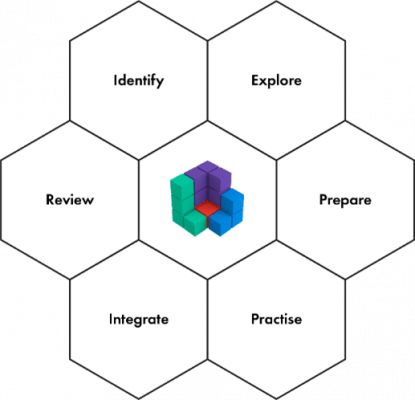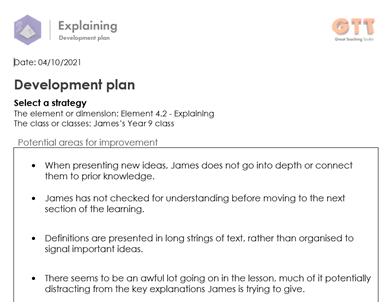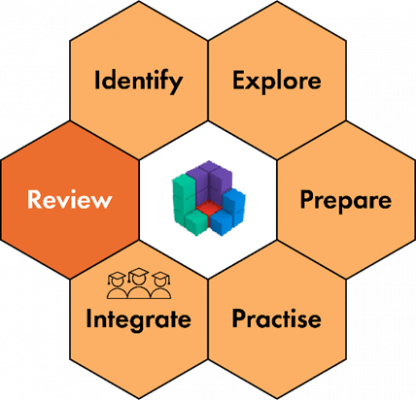In this blog, we set out to guide you through the HEX model, which features in the Great Teaching Toolkit. The HEX model is our evidence-informed suggestion for giving your professional learning the best chance of having a real impact for your students.
There is some consensus about the characteristics of effective professional development, and several influential reviews published over the past two decades (Desimone, 2009; Timperley et al., 2007; Cordingley et al., 2015) have set out conditions that seem to make it more likely to have an impact on teachers’ and students’ outcomes:
- It is sustained over time;
- It is collaborative;
- It is practice-based;
- It draws on external expertise;
- Teachers ‘buy in’ to it.
This was firmly in our minds as we created the Great Teaching Toolkit and planned the teacher journey through it; it is not a quick-fix summary of teaching tips and tricks!
The HEX model provides a suggested pathway for enacting evidence-informed change in your context, and guides you through how you can get the most from the Great Teaching Toolkit. It is comprised of six parts: Identify, Explore, Prepare, Practise, Integrate and Review.

Both classroom teachers and researchers agree that identifying the component parts of a complex skill (such as effective teaching) is one step in the process of helping a learner develop expertise (Van Merriënboer & Kirschner, 2017). In sports, athletes and coaches often identify specific aspects of a movement or tactics (such as the positioning of hands in basketball, or the movement of the hips in a golf swing), and practise this in isolation before building it into a part of the whole skill. Our Model for Great Teaching is a summary of the best available research evidence on those components of effective teaching; the things teachers do, know and believe that has the biggest impact on student learning.
Identify: The first step of your Great Teaching journey is to identify an element to focus on.
Our student perception surveys, all linked to the Model for Great Teaching, can help you identify particular areas of focus for professional development. Using the feedback tools with your students gives them a voice that may, sometimes, be hard to hear clearly: while it may seem daunting at first, every student has the opportunity to be heard, and you’ll gain a rich insight into your own practice.
Explore: The next step of the HEX model is all about exploring the evidence and strategies that might address the priorities you have identified. The Great Teaching Toolkit includes 11 courses, designed to develop your understanding of the element, see examples of it in action, and practise using it in low-stakes contexts (such as in fictional case studies). Alternatively, you could take a course external to the GTT, or deepen your understanding in a different way altogether, perhaps reading research papers, books or blogs.
Our courses cover Dimensions 2, 3 and 4 of the Model for Great Teaching.
Prepare: In this step, you will move on to preparing a development plan to address the priorities you identified earlier. Using your growing knowledge, you select a ‘best bet’ strategy (one you think is likely to help you achieve your goal) that you think could be used in your classroom. After that, you will need to adapt it to fit your specific context (e.g., tailor it to your particular student group, the subject taught, time available, etc.), ensuring that it retains the key characteristics that seem to make it effective (sometimes known as the ‘active ingredients’).

Practise your chosen strategy and get some quick feedback. No teacher would expect their students to master a complex practical skill just by reading about it; indeed, can you imagine trying to get better at tennis, football, chess, darts or yoga simply by reading about them or by watching other people do them? That’s why we suggest the next step of the HEX model is practising with a trusted colleague or a small group of students, and get some quick feedback. Doing so will highlight things that could be improved before a wider rollout (e.g., adapting resources that you’ve prepared, or changing the way you introduce the strategy).
Integrate: You have done the hard thinking preparing your development plan, now use Plan-Implement-Evaluate (PIE) cycles to integrate the new strategy into your practice.
- Plan: Make sure the adapted strategy is scheduled into your lesson plans for the class you will use it with. Also, plan to gather information to help you with formative evaluation later.
- Implement: Trial the strategy with the class (ideally over a number of lessons), and collect your formative evaluation feedback.
- Evaluate: Review the formative evaluation feedback you gathered, and reflect on the effectiveness of your strategy implementation.
Review: You will need to make a decision about what to do next. Based on the formative evaluation feedback you have gathered and reflected on, has the strategy you’ve integrated had the desired impact?
One option is to use the student surveys again to gather more feedback into your teaching. You can generate follow-up feedback on your teaching, from the class with which you implemented your adapted strategy; or generate new feedback from a new class, identify your next element of Great Teaching to focus on and continue working around the HEX model again.

It’s important to acknowledge that there are many possible pathways through the Great Teaching Toolkit. We provide the resources; it’s up to you to decide which tools you want to use, and when. The HEX model is our evidence-informed suggestion for giving your professional learning the best chance of having a real impact for your students.
References
Cordingley, P., Higgins, S., Greany, T., Buckler, N., Coles-Jordan, D., Crisp, B., Saunders, L., & Coe, R. (2015). Developing great teaching: lessons from the international reviews into effective professional development. Teacher Development Trust.
Desimone, L. M. (2009). Improving impact studies of teachers’ professional development: Toward better conceptualizations and measures. Educational Researcher, 38(3), 181–199.
Timperley, H., Wilson, A., Barrar, H., & Fung, I. (2007). Teacher Professional Learning and Development: Best Evidence Synthesis Iteration. Wellington: Ministry of Education.
Van Merriënboer, J. J. G., & Kirschner, P. A. (2017). Ten steps to complex learning: A systematic approach to four-component instructional design. Routledge.






[…] new-look development cycles is based on the GTT’s hex model, offering clear step-by-step support in your professional development activities. It makes clearer […]
[…] new-look Pathways will be based on the GTT’s hex model, offering clear step-by-step support in your professional development activities. It will have […]
[…] new-look Pathways will be based on the GTT’s hex model, offering clear step-by-step support in your professional development activities. It will have […]